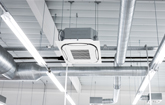DUBLIN, Dec. 3, 2020 /PRNewswire/ -- The "Indoor Air Quality Monitors - Global Market Trajectory & Analytics" report has been added to ResearchAndMarkets.com's offering.
Heavily Dependent on Discretionary Income, the Erosion in Middle Class Income Induces a -15.3% Decline in Demand for Indoor Air Quality Monitors
The global market for Indoor Air Quality Monitors is expected to slump by -15.3% in the year 2020 and thereafter recover and grow to reach US$4.6 billion by the year 2027, trailing a post COVID-19 CAGR of 7.7% over the analysis period 2020 through 2027.
Pre-COVID-19 growth which was guided by growing awareness over the different types of hazardous indoor air pollutants and the financial ability to invest air quality monitors is increasingly coming under pressure. The virus led global recession and the ensuing erosion in household wealth amid rising unemployment and business losses has massively disrupted consumer demand for indoor air monitors which is heavily dependent on discretionary income.
While the pandemic is estimated to cost trillions of dollars to the global economy, another knock-on effect of COVID-19 is the rise in unemployment across the globe. As businesses struggle to keep afloat, job cuts and bankruptcies are expected to rise sending millions into unemployment. Rapid tightening of financial conditions, dwindling trade, and increasing geopolitical tensions, continue to erode business confidence. Personal financial outlook, economy, job security confidence, and purchasing and investment confidence are all tumbling as the human and economic cost of the global pandemic rises. Unemployment rates are climbing to worrisome levels in both developed and developing economies alike.
The loss in consumer confidence and erosion of household wealth and discretionary spending will impact virtually every industry and business worldwide. The pandemic has pushed consumers to conserve cash. With unemployment rates rising amid the virus induced economic crisis, consumers are cutting spending budgets. Unemployment rates have hit never-before highs with the US topping the charts with double digit growth in unemployment rates. Social outlook against this background remains grim with households expected witness erosion in wealth.
As consumers reduce spending on digital technologies such as connected smart home devices, smartwatches, smartphones, tablets, video game consoles, among others, electronics manufacturing will also weaken. A fall-out of this general weakness in industrial and consumer consumption will result in decline in manufacturing and assembly line operations. As capital and corporate cost budgets are revised based on dwindling new orders and, falling plant capacity utilization rates, spending on plant upgrades will be delayed.
Asset strategies, for instance, will be impacted as budgets for equipment upgrades and new equipment purchases will be either repurposed or cancelled to manage the financial pressure posed by the current economic climate. Similar to residential uses of indoor air monitors, commercial use is also declining as offices close down and shift their employees to the work-from-home model.
Post COVID-19, a new addition to the existing growth drivers will be studies that link air pollution to exacerbated respiratory viral infections including COVID-19. The pandemic has focused the spotlight on indoor air quality. With no vaccine in sight, the world is now forced to reopen and learn to live with the virus. Indoor Air Quality (IAQ) refers to the physical, biological, and chemical characteristics of indoor air affecting the health or comfort of people residing in a place.
With poor IAQ being singled out as one among the major factors responsible for growing incidences of respiratory allergies and diseases, it is therefore of little surprise that indoor air quality now ranks high among the priority list of consumers. Deteriorating air quality is a major issue across the globe. Air quality, both outdoors and indoors, has a major impact on people's health. As per the World Health Organization (WHO), indoor air pollution causes nearly 2.7% diseases globally. Around 92% of total world population resides in areas wherein air quality levels tend to exceed the levels suggested by the WHO. In the last three decades, a major increase has been recorded wheezing illness in adolescents and children.
Cases of asthma have also increased considerably. Air quality monitoring devices are used to identify and track the pollutant levels in both indoor and outdoor environments that include carbon monoxide, nitrous oxide, volatile organic compounds (VOCs) and particulate matters. VOC gases arise from diverse sources and the concentration of VOCs is higher in indoor environment compared to outdoor environment. Growing health concerns will drive demand for improved air quality, which in turn is expected to drive growth in the air quality monitors market.
Given the stringent regulations on environmental pollution, several industries such as food processing, chemicals and other process industries will generate long term demand for indoor air quality monitors post COVID-19 pandemic scenario. In addition to the industrial sector, the government, commercial and residential buildings are the major users of indoor air quality monitors. As clean air continues to garner interest among all stakeholders, demand for indoor air quality monitors is expected to grow steadily in future, after a temporary lull in 2020.
Competitors identified in this market include, among others:
- 3M Company
- Agilent Technologies, Inc.
- Dwyer Instruments, Inc.
- Camfil Group
- Bacharach, Inc.
- Critical Environment Technologies Canada, Inc.
- Daikin North America LLC
- Ecotech Pty., Ltd.
- Aeroqual Limited
- E Instruments International, LLC.
Key Topics Covered:
I. INTRODUCTION, METHODOLOGY & REPORT SCOPE
II. EXECUTIVE SUMMARY
1. MARKET OVERVIEW
- COVID-19 Outbreak Poised to Dent Market Prospects in the Immediate Term
- Prevailing Weak Global Economic Environment & Negative Tide in GDP Forecasts Discourage the Indoor Air Quality Monitors Market in Short Term
- COVID-19 Restrictions and Lockdowns Led to Remarkable Improvement in Air Quality
- Correlation between Air Quality & Health Enable Indoor Air Quality Monitors to Enjoy Limelight amid COVID-19
- Resumption of Economic Activity Needs Creation of Safe, Healthy Indoor Environments
- Key Air Quality Metrics to Alleviate Risk of COVID-19 Transmission Indoors
- Strategies to Ensure Proper Monitoring of Indoor Air Quality for Fight against COVID-19
- COVID-19 Makes Indoor Air Quality Monitoring to Warrant Needed Attention
- An Overview of Indoor Air Quality Monitors (IAQM)
- Poor Air Quality: Effects on Health
- Enhancing Indoor Air Quality
- Brief Note on Technology Used in IAQM
- Selecting the Right Air Quality Monitor
- Gripping Air Pollution Helps Global Air Quality Monitors Market to Maintain Momentum with More Fervor
- Prominent Drivers Propelling Indoor Air Quality Monitors Market to Run a Marathon
- Product Type: Portable Indoor Monitors Grows the Fastest
- Analysis of Monitors by Pollutant Type
- Analysis by End-Use
- Regional Analysis: Indoor Air Quality Monitors Market Holds Bright Prospects for Asia-Pacific
- Competitive Scenario
- Recent Market Activity
2. FOCUS ON SELECT PLAYERS
3. MARKET TRENDS & DRIVERS
- Rising Awareness About Ambient Indoor Air Quality Augurs Well
- Deteriorating Air Pollution Levels & Rising Need to Improve Air Quality Spur Demand
- A Glimpse at Common Air Pollutants
- Major Indoor Pollutants and their Impact on Health: A Snapshot
- Rising Incidence of Asthma and Air Borne Allergies Provide the Perfect Platform for Market Expansion
- Rising Emphasis on IAQ in Commercial Environments Underpins Revenue Growth
- Residential Buildings: The New Growth Vertical
- Popularity of Smart Homes Drives Demand
- Relevance in Industrial Environments Bodes Well
- Novel Opportunities in Healthcare Sector
- Construction Spending Patterns Influence Uptake of IAQ Monitors
- Favorable Demographic and Socio-Economic Trends Strengthen Market Prospects
- Growing Population & Urban Sprawl
- Aging Population: A Weighty Demographic Driver
- Technology Advancements & Innovations Spur Demand
- A Review of Select Technologically Advanced IAQ Monitors
- Mobile Apps Simplify the IAQ Monitoring Process
- Select Innovations and Advancements
- Air Quality Regulations & Standards Favor Growth
- United States
- Select Other Countries
- International Air Quality Agreements
- Online Channels Enhance Product Promotion & Distribution Strategies
- Issues & Challenges
- Low Awareness Levels
- Pricing Pressures & Low Operating Margins
- Dearth of Universal Standards
4. GLOBAL MARKET PERSPECTIVE
III. MARKET ANALYSIS
- GEOGRAPHIC MARKET ANALYSIS
- UNITED STATES
- Air Monitoring: Critical to Environmental Monitoring
- Indoor Air Quality Monitors Market to Significantly Decline Amid COVID-19 Pandemic
- Negative Trend in the Residential Construction Sector Discourages the Market
- Long-Term Prospects for Monitors Remain Optimistic amid Growing Concerns over Deteriorating Indoor Air Quality
- Surging Air Pollution Levels in the United States: Steps Taken by EPA
- EPA Measures for Curbing Air Pollutants
- IAQ Awareness Drives Further Legislative Initiatives
- Market Analytics
- CANADA
- Market Overview
- Market Analytics
- JAPAN
- CHINA
- Environmental Monitoring Market to Sustain Pace
- VOC Monitoring to Drive Growth
- Changing Focus of Chinese Environmental Monitoring Program: A Comparison of Key Indicators of Air and Water Quality Monitoring for 12th and 13th Five-Year Plans
- Stringent Regulatory Standards on Air Pollution Control Steer Growth of Indoor Air Quality Monitors Market
- Market Analytics
- EUROPE
- Market Overview
- Weak Construction Activity Curtails Momentum
- Emphasis on Curbing Air Pollution Augurs Well for Long-Term Growth
- Market Analytics
- ASIA-PACIFIC
- Sluggish Scenario Deters Current Market Prospects
- Long-Term Growth Remains Intact Amid Rising Concerns over Air Pollution
- Rising Standards of Living Fuel Market Expansion
- Market Analytics
- REST OF WORLD
IV. COMPETITION
- Total Companies Profiled: 51
For more information about this report visit https://www.researchandmarkets.com/r/gmoh36
Research and Markets also offers Custom Research services providing focused, comprehensive and tailored research.
Media Contact:
Research and Markets
Laura Wood, Senior Manager
[email protected]
For E.S.T Office Hours Call +1-917-300-0470
For U.S./CAN Toll Free Call +1-800-526-8630
For GMT Office Hours Call +353-1-416-8900
U.S. Fax: 646-607-1904
Fax (outside U.S.): +353-1-481-1716
SOURCE Research and Markets

Related Links
WANT YOUR COMPANY'S NEWS FEATURED ON PRNEWSWIRE.COM?
Newsrooms &
Influencers
Digital Media
Outlets
Journalists
Opted In





Share this article